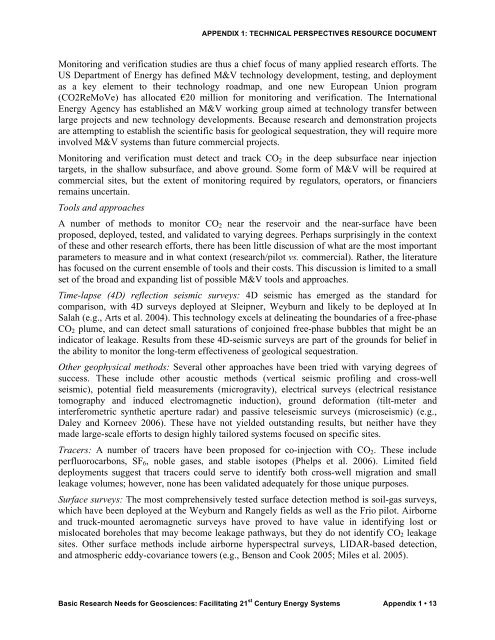Basic Research Needs for Geosciences - Energetics Meetings and ...
Basic Research Needs for Geosciences - Energetics Meetings and ...
Basic Research Needs for Geosciences - Energetics Meetings and ...
- No tags were found...
Create successful ePaper yourself
Turn your PDF publications into a flip-book with our unique Google optimized e-Paper software.
APPENDIX 1: TECHNICAL PERSPECTIVES RESOURCE DOCUMENTMonitoring <strong>and</strong> verification studies are thus a chief focus of many applied research ef<strong>for</strong>ts. TheUS Department of Energy has defined M&V technology development, testing, <strong>and</strong> deploymentas a key element to their technology roadmap, <strong>and</strong> one new European Union program(CO2ReMoVe) has allocated 20 million <strong>for</strong> monitoring <strong>and</strong> verification. The InternationalEnergy Agency has established an M&V working group aimed at technology transfer betweenlarge projects <strong>and</strong> new technology developments. Because research <strong>and</strong> demonstration projectsare attempting to establish the scientific basis <strong>for</strong> geological sequestration, they will require moreinvolved M&V systems than future commercial projects.Monitoring <strong>and</strong> verification must detect <strong>and</strong> track CO 2 in the deep subsurface near injectiontargets, in the shallow subsurface, <strong>and</strong> above ground. Some <strong>for</strong>m of M&V will be required atcommercial sites, but the extent of monitoring required by regulators, operators, or financiersremains uncertain.Tools <strong>and</strong> approachesA number of methods to monitor CO 2 near the reservoir <strong>and</strong> the near-surface have beenproposed, deployed, tested, <strong>and</strong> validated to varying degrees. Perhaps surprisingly in the contextof these <strong>and</strong> other research ef<strong>for</strong>ts, there has been little discussion of what are the most importantparameters to measure <strong>and</strong> in what context (research/pilot vs. commercial). Rather, the literaturehas focused on the current ensemble of tools <strong>and</strong> their costs. This discussion is limited to a smallset of the broad <strong>and</strong> exp<strong>and</strong>ing list of possible M&V tools <strong>and</strong> approaches.Time-lapse (4D) reflection seismic surveys: 4D seismic has emerged as the st<strong>and</strong>ard <strong>for</strong>comparison, with 4D surveys deployed at Sleipner, Weyburn <strong>and</strong> likely to be deployed at InSalah (e.g., Arts et al. 2004). This technology excels at delineating the boundaries of a free-phaseCO 2 plume, <strong>and</strong> can detect small saturations of conjoined free-phase bubbles that might be anindicator of leakage. Results from these 4D-seismic surveys are part of the grounds <strong>for</strong> belief inthe ability to monitor the long-term effectiveness of geological sequestration.Other geophysical methods: Several other approaches have been tried with varying degrees ofsuccess. These include other acoustic methods (vertical seismic profiling <strong>and</strong> cross-wellseismic), potential field measurements (microgravity), electrical surveys (electrical resistancetomography <strong>and</strong> induced electromagnetic induction), ground de<strong>for</strong>mation (tilt-meter <strong>and</strong>interferometric synthetic aperture radar) <strong>and</strong> passive teleseismic surveys (microseismic) (e.g.,Daley <strong>and</strong> Korneev 2006). These have not yielded outst<strong>and</strong>ing results, but neither have theymade large-scale ef<strong>for</strong>ts to design highly tailored systems focused on specific sites.Tracers: A number of tracers have been proposed <strong>for</strong> co-injection with CO 2 . These includeperfluorocarbons, SF 6 , noble gases, <strong>and</strong> stable isotopes (Phelps et al. 2006). Limited fielddeployments suggest that tracers could serve to identify both cross-well migration <strong>and</strong> smallleakage volumes; however, none has been validated adequately <strong>for</strong> those unique purposes.Surface surveys: The most comprehensively tested surface detection method is soil-gas surveys,which have been deployed at the Weyburn <strong>and</strong> Rangely fields as well as the Frio pilot. Airborne<strong>and</strong> truck-mounted aeromagnetic surveys have proved to have value in identifying lost ormislocated boreholes that may become leakage pathways, but they do not identify CO 2 leakagesites. Other surface methods include airborne hyperspectral surveys, LIDAR-based detection,<strong>and</strong> atmospheric eddy-covariance towers (e.g., Benson <strong>and</strong> Cook 2005; Miles et al. 2005).<strong>Basic</strong> <strong>Research</strong> <strong>Needs</strong> <strong>for</strong> <strong>Geosciences</strong>: Facilitating 21 st Century Energy Systems Appendix 1 • 13
















